Answers to Your Questions: Bracing a Gate
In e-mail recently, a question about cross-bracing (with links by me):
You said that the bottom of a tensioned cross-brace goes away from the hinge. What is a tensioned cross-brace, and when does the bottom go away from the hinge?
This is one of those things it's easier to explain in pictures, so here's my response.
First of all, a little elementary structures for those of us who are a bit rusty. We have two kinds of forces that a piece of a structure can exert: tension and compression. Tension is a force that is most like pulling, while compression is most like pushing. In addition, every time you have a force, you need to have another force in the opposite direction. This is not a building code requirement, but a law of physics.
So let's take a theoretical gate and set it on the ground. There are two forces at work here, in the simplest way of describing this world: gravity and the force of the ground pushing up against gravity. They balance each other out: if there was not enough of one or the other, the gate would sink into the ground (which happens in soil with insufficient bearing capacity and is called subsidence), or the gate would float away (which, um, is not often a problem with structures).
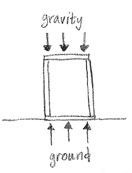
Things change a bit when you put the gate up on hinges. Now all the force holding the gate up is on the left side of the gate, where the hinges are. But gravity is still pushing down on the gate over its entire width.
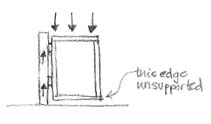
Over time, gravity will push the gate down, usually until it touches the ground, at which point it will be partially supported by the ground as well as the hinges.
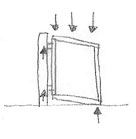
You can remove sag by transferring some of that gravity load over to the left side of the gate with a cross-brace. There are two kinds of cross-braces: compression and tension. A compression cross-brace takes weight from the top bar and transfers it by pushing down against the bottom hinge like so:
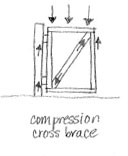
A tension cross-brace takes weight from the bottom bar and pulls it upward to the top hinge like so:
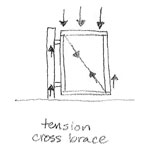
Either type of cross-brace is fine. The limits are based on your material (wood in this situation works best as a compression brace, while wire can only ever be in tension), your design (you may want a less obtrusive brace), and the application (you may want to avoid tensioned wires where children will be playing).
Technorati Tags: advice, construction, design
posted by ayse on 07/08/08